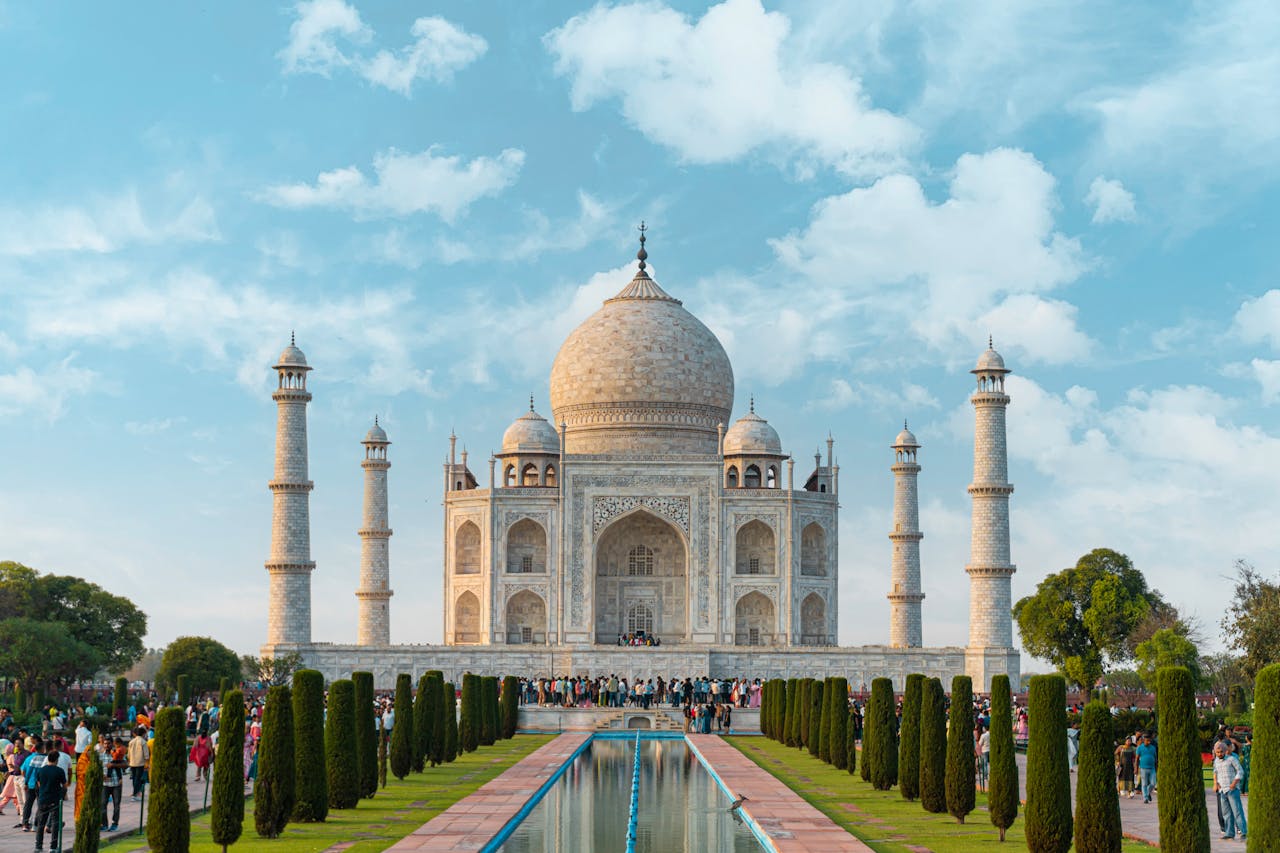In the heart of India, where history and romance intertwine, stands one of the world’s most breathtaking monuments — the Taj Mahal. With its gleaming white marble, intricate craftsmanship, and timeless beauty, the Taj Mahal continues to capture the imagination of millions around the globe.
But beyond its postcard-perfect appearance lies a story of love, loss, and an emperor’s everlasting tribute to his beloved.
Let’s take a deeper journey into the magic of the Taj Mahal — a wonder every traveler should experience at least once.
The Story Behind the Stone
Built between 1632 and 1653, the Taj Mahal was commissioned by Mughal Emperor Shah Jahan in memory of his favorite wife, Mumtaz Mahal, who tragically died during childbirth.
Grief-stricken yet determined to immortalize her, Shah Jahan envisioned a mausoleum so beautiful that it would stand as a testament to their eternal love.
The result was an architectural masterpiece, blending elements of Persian, Islamic, and Indian styles into a symphony of marble, gemstones, and delicate artistry.
Today, the Taj Mahal stands as a UNESCO World Heritage Site and one of the New Seven Wonders of the World, drawing millions who come to witness its serene beauty.
Architectural Marvel
At first glance, the Taj Mahal’s sheer symmetry and luminous glow are mesmerizing. Yet, it’s the details that truly astonish:

- The Main Dome rises 73 meters (240 feet) high and appears to float against the sky.
- The Minarets, one at each corner, are subtly tilted outward to protect the main tomb in case of an earthquake.
- The Pietra Dura technique (stone inlay work) features semi-precious stones like jade, crystal, lapis lazuli, amethyst, and turquoise forming intricate floral patterns.
- The Calligraphy, using black marble, features verses from the Quran that seem perfectly proportioned from any angle.
Everything about the Taj Mahal is a careful balance of form, light, and space — a masterpiece where architecture and emotion become one.
How to Visit the Taj Mahal
Planning your visit carefully will help you experience the Taj Mahal at its finest. Here’s how to do it:
Getting There
- By Air:
The nearest major airport is Indira Gandhi International Airport (DEL) in New Delhi, about 220 kilometers (137 miles) away. From Delhi, you can reach Agra by train, car, or domestic flight. - By Train:
The most popular and fastest option is the Gatimaan Express — a high-speed train from New Delhi to Agra Cantt Station in about 1 hour 40 minutes. Regular trains like the Shatabdi Express are also available. - By Car:
You can book a private taxi or take a comfortable ride via the Yamuna Expressway, which connects Delhi and Agra. The drive usually takes around 3 to 4 hours. - By Bus:
Air-conditioned tourist buses depart daily from Delhi, but they take longer (about 4-5 hours).
Entry Details
- Tickets:
You can buy tickets online through the official website or at the ticket counters.
Ticket prices vary for Indians, SAARC nationals, and foreign tourists. - Entry Gates:
There are three gates — East Gate, West Gate, and South Gate.
The East and West Gates are recommended for tourists as they have better facilities. - Opening Hours:
- Sunrise to Sunset (around 6:00 AM to 6:30 PM)
- Closed on Fridays for prayers.
- Night Viewing:
Available 2 days before and 2 days after the full moon, from 8:30 PM to 12:30 AM.
Limited to 400 people per night in 8 batches of 50 visitors.
Best Way to Explore
- Arrive early at sunrise to beat the crowds.
- Hire a local guide or use an official audio guide app to understand the rich history.
- Wear comfortable footwear and bring water, especially in summer months (April–June).
- Pack light — large bags are not allowed inside and security checks are strict.
- Photography is allowed in most areas except inside the main mausoleum.
Important Tips
- Respect Local Customs:
Behave respectfully inside the complex, especially near religious spaces. - Eco-Friendly Transportation:
Polluting vehicles are not allowed near the Taj Mahal. Use electric rickshaws or cycle rickshaws for the final stretch from parking lots. - Stay Hydrated:
Agra can get very hot, especially from April to July. Carry bottled water.
Best Times to Visit the Taj Mahal
The Taj Mahal’s beauty changes with the light and seasons, offering unique experiences throughout the day:
- Sunrise: Witness a soft, pinkish hue as the sun first hits the marble. It’s cooler and less crowded.
- Sunset: The marble glows warmly as the day ends, perfect for romantic moments and stunning photos.
- Full Moon Nights: A magical experience — the Taj Mahal bathed in silver moonlight.
Travel Tip: October to March is the best season to visit, avoiding the intense summer heat and monsoon rains.
Beyond the Taj: Explore Agra
While the Taj Mahal is Agra’s shining star, don’t miss:
- Agra Fort: Where Shah Jahan spent his final years imprisoned, gazing at the Taj.
- Mehtab Bagh: A peaceful garden across the river, ideal for sunset views.
- Fatehpur Sikri: A UNESCO-listed ghost city built by Emperor Akbar, just an hour away.
Why the Taj Mahal Continues to Inspire
The Taj Mahal isn’t just a building; it’s a story — of love, devotion, and artistic genius.
Every carved petal, every inlaid gemstone, whispers tales from a time when empires rose and fell, but love endured.
For travelers, standing before the Taj is more than sightseeing — it’s a profound, humbling, and unforgettable experience.
Final Thoughts: A Love Letter in Marble
Few places in the world live up to their reputation, but the Taj Mahal exceeds every expectation. Whether it’s your first visit or your fifth, its breathtaking beauty and timeless story will leave a mark on your heart.
If your soul seeks wonder, history, and inspiration, let the Taj Mahal be your next great journey.

